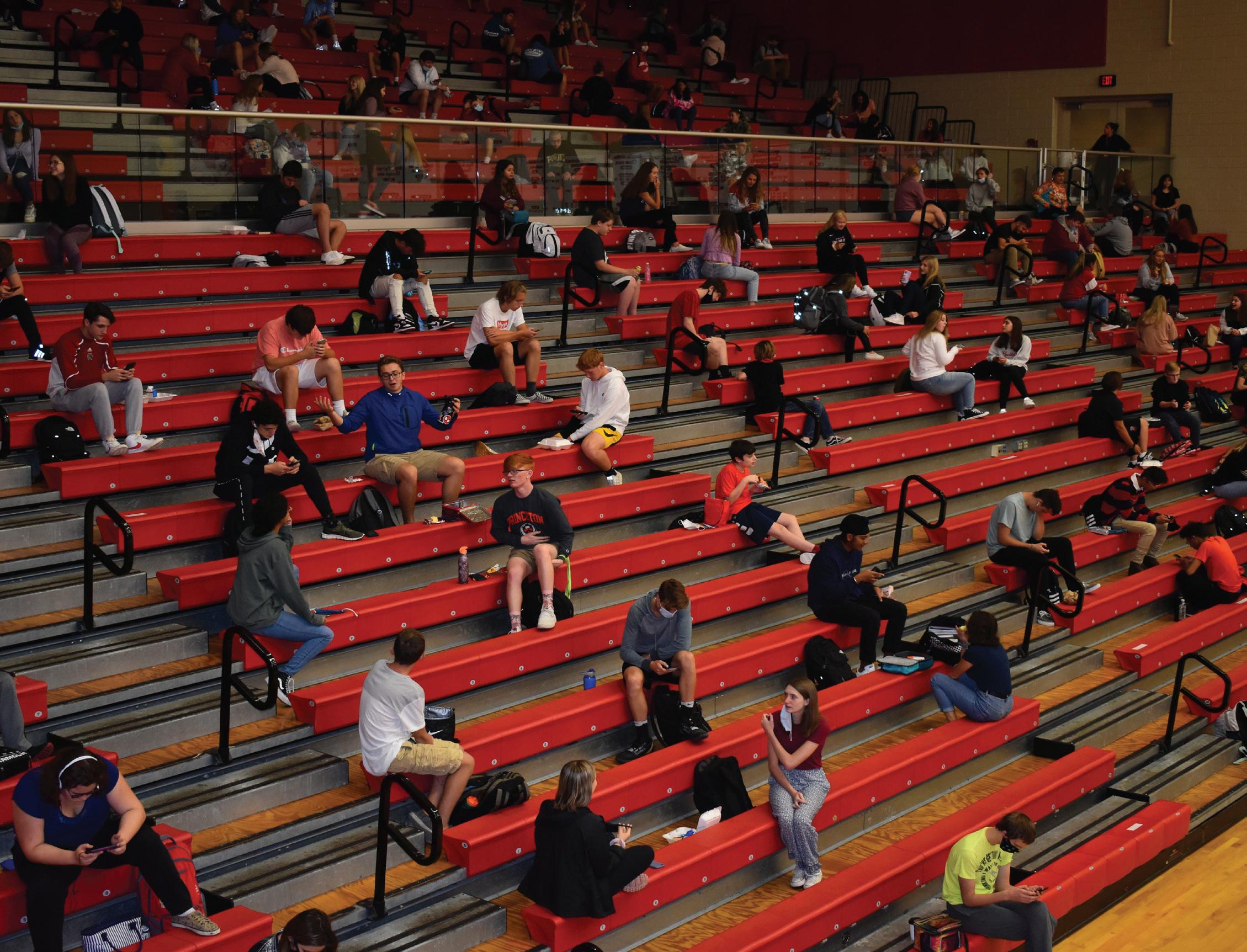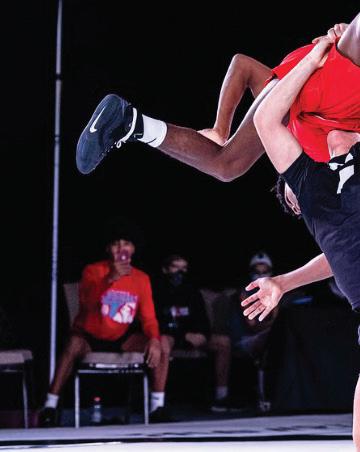
7 minute read
REPORTING COVID-19 CASES
from Inklings
Students enjoy their lunch spaced out in the gym. This protocol was added to prevent the spread of COVID-19 and to lessen the amount of contact tracing in response to a positive case.
PHOTO BY EMILY HELMUTH
Advertisement
Procedures on reporting COVID-19 cases; specific steps to inform public
BY ROSALIE DEGENHART ABBY GODSEN assisstant editors
COVID-19 has had a heavy impact recently at Crown Point High School as groups of teachers and students have been leaving the school campus to quarantine for two weeks. This past week, CPHS has reported 196 staff and student quarantines, while the entire corporation has reported 683 staff and student quarantines. These cases and quarantines are reported through an email sent out to parents by Chief Human Resource Officer of the Crown Point Community School Corporation Arthur Equihua, who plays a major role in the process of contact tracing. CPCSC uses three sources to gain advice on safety protocols during COVID-19.
“It’s actually sort of guidance from a number of entities that we lean on for ad vice on how to handle COVID officially. The three main sources we use would be the CDC, the Indiana Health Department, and then our local Lake County Health Department,” Equihua said.
Communicating with these departments is an important step in accurately reporting COVID-19 cases.
“We have two individuals that are identified as official people to communicate with any of the health departments regarding our cases. That would be an administrator from any building and the nurse,” Equihua said. “We really want the nurse to be that initial point of communication, and there’s an interview sheet that she uses, each of our nurses in all of our schools, and, we’ve actually trained our substitute nurses to do this, to work through the standard set of questions that help us understand the case and the potential impact on our school campus sites.”
Even before the information of a positive case is released, Equihua comments on how that information is reported to the school in the first place.
“We may receive a report of a positive
case in a number of ways. Hopefully, families might lag a little bit from when we’re notified, or students, if it’s happening to them, we’re it depends on the complexity of the case, but hoping for and we ask that they call the school, usually within a couple of days,” Equihua said. and they are. Families are responding wonder- Equihua’s job also includes updating the fully. They usually call the principal, it might COVID-19 chart found on the CPCSC webbe an assistant principal that receives the call, site. With the influx of quarantines, every efpossibly the nurse, but more than likely it’s go- fort is made to update it daily. The date chart ing to be an administrator at the school that is displays the number of positive cases and going to be notified,” Equihua said. quarantines at each individual school through-
According to Equihua, information of a out the week. positive case in the CPCSC can also be report- “I’m receiving information from all the ed to the CPCSC by the local health depart- schools, making sure that we’re following the ment. rules and doing a good job, and I’m trying to
“You know, ‘Crown Point schools, we get the schools’ support if they need it to do have a positive case that we need to make you the contact tracing. Then, when I get the final aware of,’ and the reverse, so there’s a little bit reports, I’ll adjust the sheets. By the end of of redundancy in the reporting, but I think that’s a good thing. Normally, no, we cannot share any information that would identify an individual, that ‘‘ I’m receiving information from all the schools, making sure we’re following the rules and doing a the week, we want to make sure for that week, we’re current, so that folks can see what’s happened that week and what’s the impact,” Equihua would a staff member good job, and I’m trying to said. or student, frankly,” Equihua said. get the schools’ support if It is important to Equihua that the data
Once a case has they need it to do the con- of cases and quarbeen verified at a tact tracing. antines is accurate school, administrators before updating the at that school begin Chief Human Resource Officer chart. the process of contact tracing for that COVID Arthur Equihua “We try to update it throughout case. the week if we can.
“We have teams at every building that If I can make appropriate updates to it at the begin to break down the data and start to de- end of the day I try to. But, once again we termine and understand who’s been near that want to be as accurate as we can, so we aren’t individual, starting on X date,” Equihua said. changing the numbers all the time,” Equihua “We’re pulling out seating charts, bus charts, said. “It takes a lot to watch, I know there’s watching bus videos, talking to teachers, ‘did assigned seats, but we also know that students you change your student seating chart that sometimes change seats on the bus. We need to day? Did you do an activity that took you out really take our time, and we might catch someof your seats for that day?’ All these conversa- thing a day later, but we’re pretty good, getting tions are taking place.” it done in a reasonable amount of time.”
The process of contact tracing varies de- While COVID-19 cases are reported to pending on how many people that person was parents and teachers, FERPA, the Family Edin contact with. ucational Rights and Privacy Acts, prevents
“In some instances, it may be processed educational records, including medical, from rather quickly, there was no contact with any- being shared with the public. This means that body, easy peasy. In some instances, not so if a faculty member or student at a school tests much. We’re working on it for a day or two positive, the teachers and parents are not notior more. It just depends on the situation and fied who that specific student is, neither does the breadth of the potential contacts. What the email specify. we want to make sure though is that we try to “We are not able to share information inform the school community that is affected about a student file with anybody that doesn’t with an email.” have any legal or practical means to see it,
Equihua is the source of the emails sent Equihua said. “We work with local authorities out to parents, which report recent quarantines on sharing student file information, that could in the corporation. be the police, child services, and, in this case,
“That email, we want to push out when the health department. What we can share is we feel confident of those numbers, so that positive cases and quarantines per school.”
INTHEKNOW
NHS hosting virtual food drive; goal of $5000 by Nov. 25
NHS will be hosting a virtual food drive now through Nov. 25. The CPHS chapter’s goal is to raise $5000, and the money will go to the Food Bank of Northwest Indiana. NHS’ directors’ official statement is: “With COVID-19, there are countless families who have been financially impacted. The holidays are coming up, and our chapter of the National Honor Society wanted to do anything possible to help. Our goal is to raise money to help feed families across Northwest Indiana. NHS values our community, and we want to help our fellow Hoosiers” Donations can be made at https:// secure.qgiv.com/event/cphsn/. Yearbook personal ads now available
As of Nov. 5, seniors can now purchase yearbook personal ads. These ads’ sizes range from a 16th of a page to a full page, with costs ranging from $35 to $400. All ad requests are due by Feb. 14. The form can be found in seniors’ school email inbox and can be turned in to Lisa Keene.
Student Council’s blood drive at First Methodist Church
CPHS Student Council will continue to host its annual blood drive with the American Red Cross, but contrary to past years it will be at First Methodist Church instead of the field house. The drive will be from 1:30 p.m. to 6:30 p.m. on Friday Nov. 20. Students who are 16 or older can donate, but 16-year-olds need a parents signature to donate, while 17-year-olds do not. Donors must also weigh at least 100 lbs, with donors under 18 needing to fit additional requirements that can be found on the Red Cross website.










